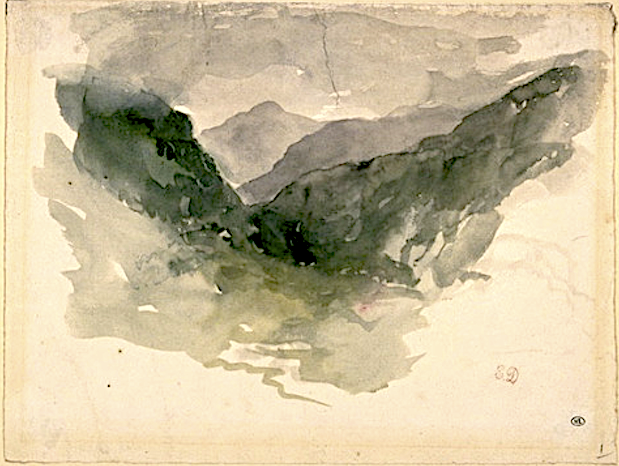
EUGÈNE DELACROIX (1798-1863)
Le Canigou (2,784m - 9,137 ft)
France (Pyrénées)
In Album Pyrénées, 1845, Carnet de dessins et aquarelles, Musée du Louvre, Paris
La montagne
Le Canigou (2,784m - 9,137 ft) est une montagne située dans les Pyrénées-Orientales (sud de la France), au sud de Prades et au nord de Prats-de-Mollo-la-Preste. Son sommet est un quadripoint entre les territoires de Casteil, Taurinya, Valmanya et Vernet-les-Bains. Sa situation le rend visible depuis les plaines du Roussillon et du Conflent en France, ainsi que depuis l'Empordà en Espagne. En raison de ses flancs acérés et de sa situation spectaculaire à proximité de la côte, le Canigou était considéré jusqu'au XVIIIe siècle comme la plus haute montagne des Pyrénées.Deux fois par an, début février et fin octobre, par beau temps, le Canigou peut être aperçu au coucher du soleil jusqu'à Marseille, à 250 km, par réfraction de la lumière. Ce phénomène fut observé en 1808 par le baron Franz Xaver von Zach de la basilique Notre-Dame de la Garde à Marseille. Toute l'année, on l'observe également, par beau temps, depuis Agde, Port-Camargue et la Montagne Noire.La montagne a une signification symbolique pour le peuple catalan. À son sommet se dresse une croix souvent décorée du drapeau catalan. Chaque année, le 23 juin, la veille de la nuit de la Saint Jean, jour du solstice d'été, a lieu une cérémonie appelée Flama del Canigó (Flamme du Canigou), au cours de laquelle un feu est allumé au sommet de la montagne. Les gens veillent pendant la nuit et prennent les torches allumées sur le feu lors d'un spectaculaire relais de flambeaux pour allumer des feux de joie ailleurs. De nombreux feux de joie sont allumés de cette manière dans toutes les Pyrénées-Orientales, en Catalogne, dans la Communauté valencienne et en théorie dans les îles Baléares.
Le peintre
Ferdinand Victor Eugène Delacroix était un artiste romantique français considéré dès le début de sa carrière comme le chef de file de l'école romantique française. L'utilisation par Delacroix de coups de pinceau expressifs et ses études sur les effets optiques de la couleur ont profondément façonné le travail des impressionnistes, alrors que sa passion pour l'exotisme a inspiré les artistes du mouvement symboliste. Fin lithographe, Delacroix a illustré diverses œuvres (William Shakespeare, Walter Scott et Goethe notamment).
Contrairement au perfectionnisme néoclassique de son principal rival Ingres, Delacroix s'est inspiré de l'art de Rubens et des peintres de la Renaissance vénitienne, en mettant l'accent sur la couleur et le mouvement plutôt que sur la clarté des contours et la forme soigneusement modelée. Le contenu dramatique et romantique caractérise les thèmes centraux de sa maturité et le conduit non pas vers les modèles classiques de l'art grec et romain, mais plutôt vers les voyages en Afrique du Nord à la recherche de l'exotisme. Ami et héritier spirituel de Théodore Géricault, Delacroix s'inspire également de Lord Byron, avec qui il partage une forte identification aux « forces du sublime », et aux actions de la nature, souvent violente.
Cependant, Delacroix n'était enclin ni à la sentimentalité ni à l'emphase, et son romantisme était celui d'un individualiste. Selon les mots de Baudelaire : « Delacroix était passionnément amoureux de la passion, mais froidement déterminé à exprimer sa passion le plus clairement possible ».
En 1832, Delacroix se rend en Espagne et en Afrique du Nord, dans le cadre d'une mission diplomatique au Maroc peu après la conquête de l'Algérie par la France. Il n'y est pas allé pour étudier l'art, mais pour échapper au parisianisme dans l'espoir d'approcher une culture plus primitive. Il a produit plus de 100 peintures et dessins de scènes tirées ou basées sur la vie des peuples d'Afrique du Nord, et a ajouté un nouveau chapitre très personnel à l'intérêt général porté alors à l'orientalisme. Delacroix était fasciné par les gens et les costumes, et le voyage allait éclairer le sujet d'un grand nombre de ses futurs tableaux. Il pensait que les Nord-Africains, dans leurs vêtements et leurs attitudes, fournissaient un équivalent visuel aux peuples de la Rome et de la Grèce classiques : « Les Grecs et les Romains sont ici à ma porte, chez les Arabes qui s'enveloppent dans une couverture blanche et regardent comme Caton ou Brutus..."
Il réussit à dessiner secrètement quelques femmes à Alger, comme dans le tableau Femmes d'Alger dans leur appartement (1834), mais il rencontra généralement des difficultés à trouver des femmes musulmanes prêtes à poser pour lui en raison des règles musulmanes exigeant que les femmes soient couvertes. La peinture des femmes juives d’Afrique du Nord, comme sujets du Mariage juif au Maroc (1837-1841), pose moins de problèmes.
À Tanger, Delacroix réalise de nombreux croquis des gens et de la ville, sujets sur lesquels il reviendra jusqu'à la fin de sa vie. Les animaux, incarnation de la passion romantique, ont été incorporés dans des peintures telles que Chevaux arabes se battant dans une écurie (1860), La Chasse au lion (dont il existe de nombreuses versions, peintes entre 1856 et 1861) et Arabe sellant son cheval (1855). .
_________________________________________
2024 - Gravir les montagnes en peinture
%20et%20Veleta%20(3%20396%20m)..png)
